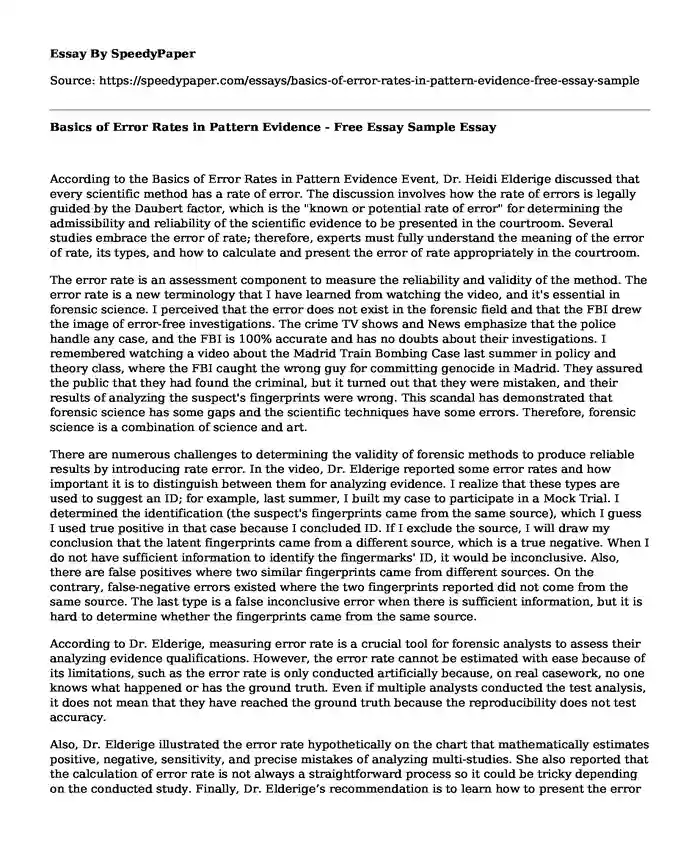
| Type of paper: | Essay |
| Categories: | Science |
| Pages: | 3 |
| Wordcount: | 701 words |
According to the Basics of Error Rates in Pattern Evidence Event, Dr. Heidi Elderige discussed that every scientific method has a rate of error. The discussion involves how the rate of errors is legally guided by the Daubert factor, which is the "known or potential rate of error" for determining the admissibility and reliability of the scientific evidence to be presented in the courtroom. Several studies embrace the error of rate; therefore, experts must fully understand the meaning of the error of rate, its types, and how to calculate and present the error of rate appropriately in the courtroom.
The error rate is an assessment component to measure the reliability and validity of the method. The error rate is a new terminology that I have learned from watching the video, and it's essential in forensic science. I perceived that the error does not exist in the forensic field and that the FBI drew the image of error-free investigations. The crime TV shows and News emphasize that the police handle any case, and the FBI is 100% accurate and has no doubts about their investigations. I remembered watching a video about the Madrid Train Bombing Case last summer in policy and theory class, where the FBI caught the wrong guy for committing genocide in Madrid. They assured the public that they had found the criminal, but it turned out that they were mistaken, and their results of analyzing the suspect's fingerprints were wrong. This scandal has demonstrated that forensic science has some gaps and the scientific techniques have some errors. Therefore, forensic science is a combination of science and art.
There are numerous challenges to determining the validity of forensic methods to produce reliable results by introducing rate error. In the video, Dr. Elderige reported some error rates and how important it is to distinguish between them for analyzing evidence. I realize that these types are used to suggest an ID; for example, last summer, I built my case to participate in a Mock Trial. I determined the identification (the suspect's fingerprints came from the same source), which I guess I used true positive in that case because I concluded ID. If I exclude the source, I will draw my conclusion that the latent fingerprints came from a different source, which is a true negative. When I do not have sufficient information to identify the fingermarks' ID, it would be inconclusive. Also, there are false positives where two similar fingerprints came from different sources. On the contrary, false-negative errors existed where the two fingerprints reported did not come from the same source. The last type is a false inconclusive error when there is sufficient information, but it is hard to determine whether the fingerprints came from the same source.
According to Dr. Elderige, measuring error rate is a crucial tool for forensic analysts to assess their analyzing evidence qualifications. However, the error rate cannot be estimated with ease because of its limitations, such as the error rate is only conducted artificially because, on real casework, no one knows what happened or has the ground truth. Even if multiple analysts conducted the test analysis, it does not mean that they have reached the ground truth because the reproducibility does not test accuracy.
Also, Dr. Elderige illustrated the error rate hypothetically on the chart that mathematically estimates positive, negative, sensitivity, and precise mistakes of analyzing multi-studies. She also reported that the calculation of error rate is not always a straightforward process so it could be tricky depending on the conducted study. Finally, Dr. Elderige’s recommendation is to learn how to present the error rate appropriately in the courtroom by articulating to the jury that the error rate was estimated from national studies at particular conditions similar to casework. Also, it shows the figures of the error rate percentage of a specific field and conducts tests to reduce these errors.
Conclusion
In conclusion, the Basics of Error Rates in Pattern Evidence event helped me learn and explore more about forensic science disciplines. It helps me to understand how to read and calculate the error rate in studies. Most important is to learn how to talk about error rates in a courtroom as an expert.
Cite this page
Basics of Error Rates in Pattern Evidence - Free Essay Sample. (2023, Dec 04). Retrieved from https://speedypaper.com/essays/basics-of-error-rates-in-pattern-evidence-free-essay-sample
Request Removal
If you are the original author of this essay and no longer wish to have it published on the SpeedyPaper website, please click below to request its removal:
- Why the World Isn't Flat - Globalization Essay Example
- Essay Sample on How Good Architectural Designs Impact People's Lives
- Paper Example. Open Banking Application Programming Interface in Hongkong
- Managing the Dangers and Cultivating the Value of Customers' Data: Free Essay
- Paper Example of a Peer-Reviewed Journal Article
- Literary Analysis Essay on The Social Life of DNA
- Neural Network - Free Paper Example
Popular categories




